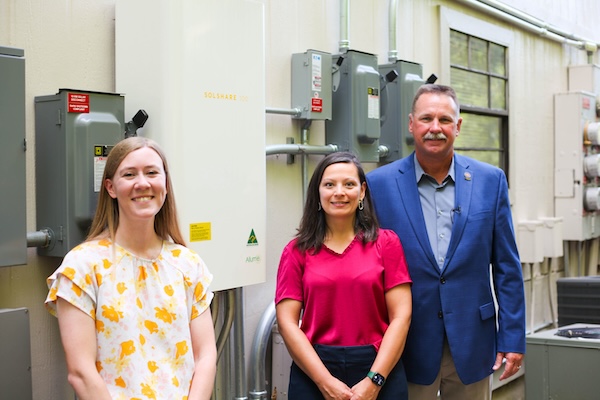Unlocking Shared Rooftop Solar for Multifamily Residents
Unlocking Shared Rooftop Solar for Multifamily Residents
The Environmental Protection Agency's (EPA) Solar for All initiative is a transformative program designed to bring the benefits of solar energy to low-income and disadvantaged communities across the United States. With a substantial $7 billion in funding, this initiative aims to expand access to affordable, resilient, and clean solar energy, targeting the deployment of residential rooftop solar, community solar projects, and storage solutions. While the current focus has largely been on low-to-moderate-income single-family homes and community solar, an often-overlooked opportunity lies in multifamily buildings
Current focus and challenges
The majority of Solar for All funding is currently directed towards low-to-moderate-income (LMI) single-family homes and community solar projects due to their easier implementation and proven benefits. Where a single-family home installation typically involves fewer stakeholders and simpler logistical planning, making it more straightforward to execute, multifamily buildings — particularly those housing low-income residents — present a significant, yet underutilized opportunity.
Deploying solar in multifamily settings, however, is inherently more complex than single-family homes for several reasons:
- Technical and logistical hurdles: Historically, multifamily solar installations required multiple systems (one for each unit) which is cost-prohibitive for building owners.
- Split incentive problem: Solar benefits, primarily in the form of lower utility bills, flow more to tenants than building owners, discouraging investment.
- Complex ownership models: Multifamily buildings often have intricate ownership structures, complicating decision-making and prolonging the process.
- Financial constraints: Affordable housing developers operate on tight budgets, making large upfront investments challenging; these developers often work with margins as slim as 3-5 percent, limiting capital for projects like solar installations.

Tenant at Jackson, MS - Daren Washington, working from home - Daren told us his bill went from $135 average per month to $75
Limitations of Community Solar
While community solar is a crucial solution for providing energy equity to low-income communities, it also has its limitations:
- Geographical constraints: As of 2020, only 20 states and Washington D.C. had policies supporting these projects.
- Reliance on third parties: Community solar depends on third-party entities, utility policies, and specific programming, which can vary significantly by region.
- Billing issues: Complex billing processes can lead to errors and confusion. One survey indicated that 65 percent of community solar customers experienced billing issues within the first year.
- Reduced financial benefits: Community solar participants often see savings of 10-20 percent on utility bills, compared to 40-70 percent with direct rooftop solar. This difference can significantly impact the financial viability and attractiveness of community solar projects.
Innovations Facilitating Multifamily Solar
Despite these challenges, recent technological advancements and innovative business models have made direct rooftop solar consumption feasible for multifamily buildings:
- Innovative solar distribution systems: New systems allow multiple units in a building to share a single solar installation, reducing the need for individual systems and cutting costs significantly. These advancements can lower installation costs by up to 30 percent, making solar more accessible for multifamily buildings.
- Battery storage: Integrating solar with battery storage enhances resilience against extreme weather and blackouts, providing uninterrupted power. The cost of battery storage has decreased by 87 percent from 2010 to 2020, making this more viable and attractive for multifamily buildings.
- Direct ownership models: These models protect customers from reductions in net energy metering (NEM) policies, ensuring they capture the full retail rate of electricity. Direct ownership systems have shown 15-20 percent higher savings compared to third-party-owned systems in initiatives like the California Solar Initiative.
Importance of Multifamily Solar
Focusing on multifamily buildings for solar deployment is crucial for several reasons:
- Density of beneficiaries: Multifamily buildings house more residents who can benefit from rooftop solar; a 50-unit building can provide solar benefits to 50 families, compared to a single-family home benefiting one family. This density amplifies the impact of each solar installation.
- Higher energy burden: Low-income multifamily residents typically face higher energy burdens compared to single-family home residents. Reports show these households spend three times more of their income on energy costs compared to the average household, making energy savings from solar particularly valuable.
- Energy equity: Enabling direct solar consumption for multifamily residents helps address energy equity, involving more communities in the clean energy transition.
Strategic Recommendations for Solar for All Winners
For the winners of the Solar for All funding, strategically including multifamily buildings in solar deployment plans can drive significant growth and community impact. Here are key recommendations:
- Leverage policy incentives: Take advantage of federal, state, and local incentives aimed at promoting solar in multifamily housing. Policies such as the Investment Tax Credit (ITC) and specific grants for low-income housing can offset installation costs and improve project viability.
- Collaborate with affordable housing developers: Partnering with developers of affordable housing can facilitate the integration of solar into new and existing multifamily buildings. These collaborations can align financial and environmental goals, making solar projects more attractive.
- Seek expertise from multifamily solar specialists: Engage with experts who understand the unique challenges and needs of multifamily solar projects. These specialists can help navigate the complexities of ownership models and financial considerations, ensuring successful implementation.
- Ensure incentives align with financial considerations: Design incentives that meet the financial goals and expected returns of multifamily building owners. Attractive incentives are crucial for encouraging investment in solar installations.
- Promote energy equity: Create programs that incentivize building owners to share higher percentages of their rooftop solar generation with their residents. This approach not only supports energy equity but also enhances the overall community impact of solar projects.

SolShare at Jackson, MS - launch event at Jackson, MS project from left: Alicia Brown, City of Savannah, Jennifer Welch, building owner of Belhaven Residential and Commissioner Brent Bailey, Mississippi Public Service Commissioner
Conclusion
Solar for All funding has the potential to significantly impact low-income communities by supporting solar projects in multifamily buildings. These buildings house many residents who can greatly benefit from direct solar consumption. While deploying solar in multifamily settings is more complex, innovative solutions available today make it feasible. Grant recipients must recognize the untapped potential of multifamily solar and include these projects in their plans to ensure a more equitable distribution of clean energy benefits.
By addressing the challenges and leveraging the latest technological innovations, Solar for All can ensure a more inclusive and impactful deployment of solar energy, benefiting a broader range of communities and contributing to a sustainable and equitable energy future. The solar industry has a unique opportunity to drive this transformation, promoting not only environmental sustainability but also social equity through strategic and innovative approaches to multifamily solar deployment.
 Aliya Bagewadi is the US Director of Strategic Partnerships at Allume Energy. In this role, she collaborates with property developers, solar installers, utilities, and policymakers to develop solutions that benefit tenants, building owners, and power companies. Prior to joining Allume, Aliya worked as a strategy consultant for Fortune 500 companies and in international development in Southeast Asia. She holds degrees from the University of Chicago and the University of Cambridge where she was a Gates Cambridge Scholar.
Aliya Bagewadi is the US Director of Strategic Partnerships at Allume Energy. In this role, she collaborates with property developers, solar installers, utilities, and policymakers to develop solutions that benefit tenants, building owners, and power companies. Prior to joining Allume, Aliya worked as a strategy consultant for Fortune 500 companies and in international development in Southeast Asia. She holds degrees from the University of Chicago and the University of Cambridge where she was a Gates Cambridge Scholar.
Allume Energy | www.allumeenergy.com
Author: Aliya Bagewadi
Volume: 2024 September/October












